Turning the phone master into a beautiful servant
How to set one-time systems to break distractions, reduce time waste and use your phone to move toward your goals
“The Mind is a beautiful servant, but a dangerous master”.
– Osho
The human mind is amazing, it allows us to solve problems, make better decisions, plan for the future, etc..
But if left unchecked, our mind can cause tremendous misery.
Anxiety, worries, and regrets are all ills caused by the mind.
An overactive mind:
- brings you away from the present.
- makes up unlikely and pessimistic scenarios and assumptions.
- gets you caught in endless desires, making you dissatisfied and always seek more.
In these cases, the mind becomes a “dangerous master”. It takes control of you, making your life worse.
This analogy of the mind applies very well to our phones.
“The Smartphone: a beautiful servant, a dangerous master”.
If used wisely, smartphones give us access to all the knowledge in the world. They empower us to learn nearly any skill and to connect with the wisest people on Earth.
Yet, our phones can also make us miserable and cause us to waste many hours of our precious lives:
mindlessly scrolling…
watching photos of people’s staged lives…
reading fear-producing news etc…
All these activities make us feel worse. Yet we still do them, on autopilot, guided by our phone master.
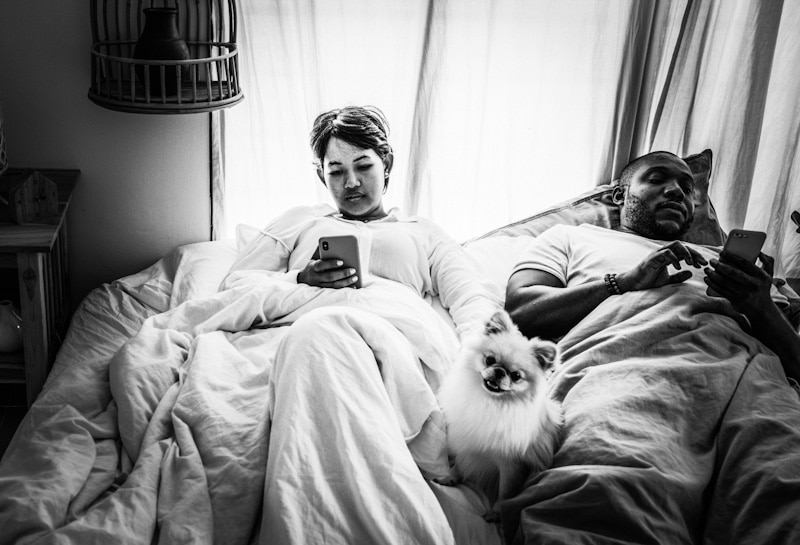 Photo by Ketut Subiyanto from
Pexels
Photo by Ketut Subiyanto from
Pexels
And then we have notifications.
They unfailingly distract us, make us lose focus, and take us away from our loved ones. To continue the analogy to an extreme, you can think of notifications as the Master calling his slave to his attention throughout the day.
We often say that time is our most important resource.
To make the most out of our time, we have to pay attention to the right things (these are different for everyone). By scattering our attention, smartphones cause us to misuse time.
The average person checks their phone 96 times a day. Are we consciously choosing to do so? Or are we the slaves of our Phone Master?
 Photo by ROMAN ODINTSOV from
PexelsTristan Harris, ex design ethicist at
Google, explained that phones (and apps) are designed to create an addictive
feeling, similar to that in slot machines.
Photo by ROMAN ODINTSOV from
PexelsTristan Harris, ex design ethicist at
Google, explained that phones (and apps) are designed to create an addictive
feeling, similar to that in slot machines.
They do that through “intermittent rewards”.
You pull a lever (open an app, unlock your phone), and either get a prize (likes, notifications) or nothing. This mechanism has been found to maximize addictiveness.
Taming the Master
How then, can we start taming this master and make it our servant?
If we make it work for us, our phone can help us move towards our goals, improve our moods, and make us better overall.
Of course, it’s not an easy feat. There are “hundreds of engineers whose job daily is to invent new ways to keep you hooked”.
Yet, there are some steps that we can take to move in that direction.
A good way to think about self-control problems, (as explained by Thaler and Sunstein in Nudge), is to see any person as “containing two semi-autonomous selves, a far-sighted Planner and a myopic Doer”.
– Our Planner is rational and concerned with our long-term well-being.
– Our Doer lives in the moment and is easily susceptible to temptations and emotions.
Knowing this, we can have our Planner set up situations that don’t tempt the Doer to indulge in negative behaviors, while making positive ones effortless and automatic.
This is also one of the main points of James Clear’s Atomic Habits, which inspired me to improve my life in many ways and write this article.
“Environment is the invisible hand that shapes human behavior. Despite our unique personalities, certain behaviors tend to arise again and again under certain environmental conditions.“
– James Clear
With phone use, the main environment to be modified is the phone itself.
Below I outlined five principles that helped me to encourage positive behaviors, reduce phone use, and increase productivity.
Any of these principles can be implemented on their own. It does not need to be integrated with the others.
- Actively track time on your phone (“What gets measured gets managed”)
- Make your phone less attractive
- Make positive behaviors visible and easy (and “negative” behaviors hidden and difficult)
- Nurture your focus
- Schedule your distractions
1. Actively track time on your phone (“What gets measured gets managed”)
If we don’t know where we are, how can we know how to get where we want to go?
Most people are not very conscious of their technology habits.
They never checked their stats, but once they do, they’re surprised by how much time they spend on their phones. Research says that, on average, people spend more than 4 hours a day on their phones, but they are unconscious of it.
Simply becoming aware of an unconscious bad habit, can be a great motivator to set up systems to improve.
On both Android and iPhone this is now very easy. Both systems have native apps that track your time on screen, the number of times you unlock your phone, and the time spent on each app.
![]() Seeing the raw numbers once in
a while though, may not be very meaningful. You may easily forget them and stop paying attention after a while.
Seeing the raw numbers once in
a while though, may not be very meaningful. You may easily forget them and stop paying attention after a while.
For this reason, I recently started logging my main stats in a spreadsheet as part of my weekly review. If you want to try you can create a copy of the spreadsheet I created here.
This way I’m sure to consistently check how I’m doing. This also helps me assess if anything I implemented has made things better or worse.
Android Instructions: Settings → Digital Wellbeing
iPhone Instructions: Settings → Screen time
To add Screen Time as a Widget to your Day View: swipe right to get to the Today view, scroll to the bottom, and tap “Edit.” Find Screen Time and tap the green “+” to add it to your Today view.
2. Make your phone less attractive
Your phone is designed to be an attractive and addictive toy.
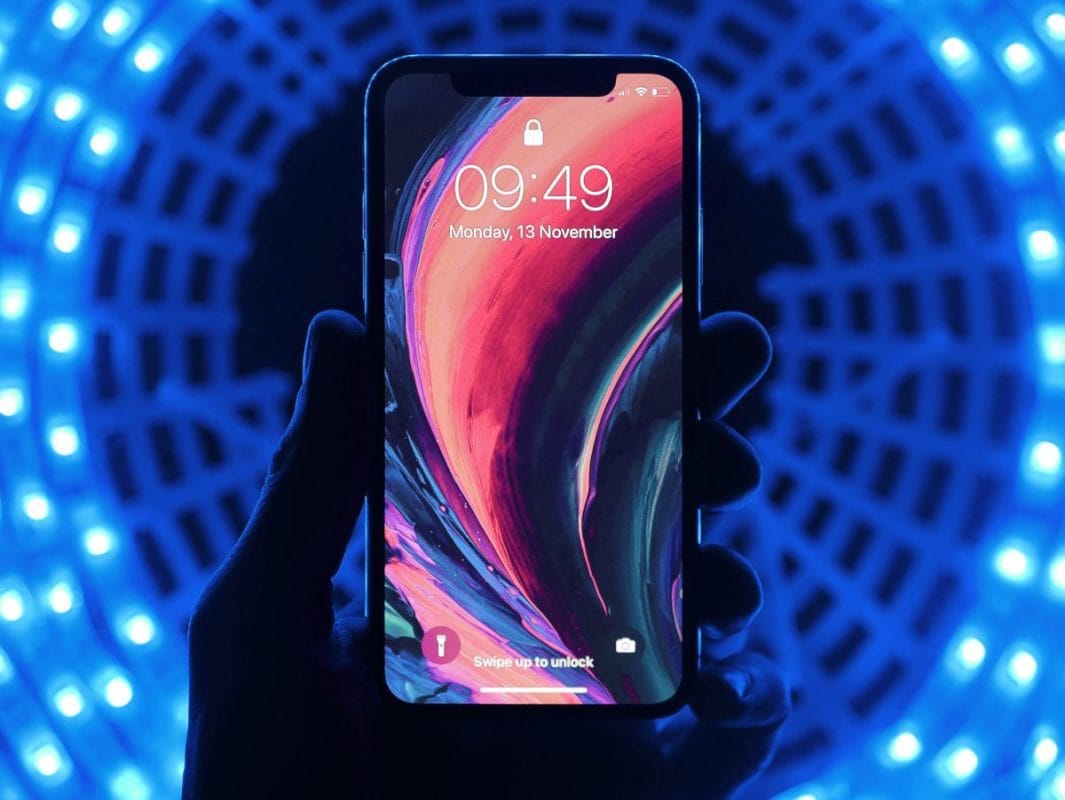
Did you ever catch yourself unlocking your phone, swiping through the pages, and putting it back in your pocket?
That’s very common and is driven by our desire to seek novelty. (colorful icons and notifications).
“We compulsively swipe through our phones without actually doing anything.“
– Tristan Harris
Sometimes people even “imagine” vibrations as an excuse to unlock and check their phones.
If you want to have full control of when you use your phone and for what purpose. There are a few things you can do to prevent this.
2.1 Black home screen and grayscale
You can start using a plain background for your home and lockscreen, ideally black.
Using black automatically destroys the idea that your phone is a shiny toy to look at all the time.
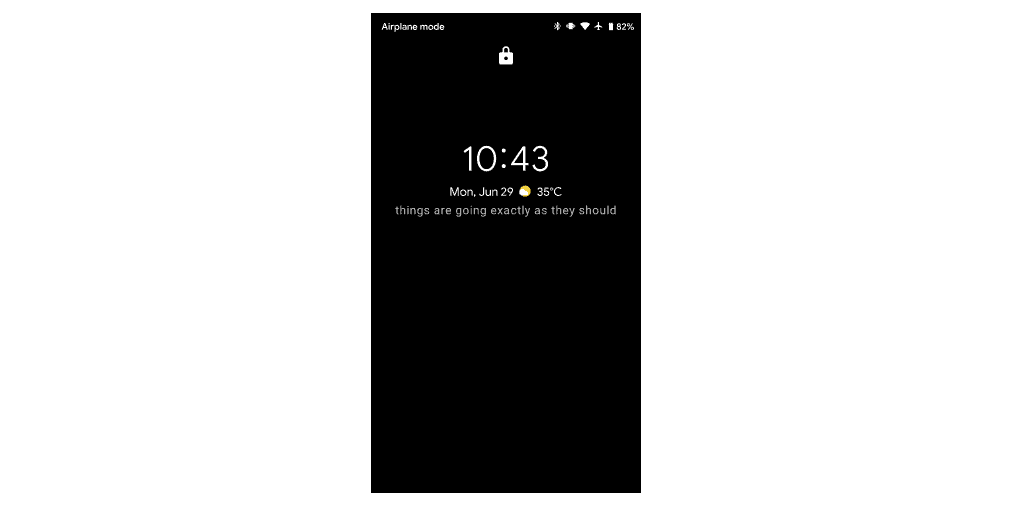
The first few days it will seem awfully boring. That’s good! Over time, you may even grow to like the minimalist, zen background.
What’s most important is that unconsciously, your phone will be less attractive. As a plus, your phone’s battery will also last longer.
If instead, you want to go a step further, you can set-up your phone to grayscale, which has been shown to decrease smartphone use.
With gray scale, you strip away all the neuron-stimulating colors on your phone that contribute to making our phones addictive.
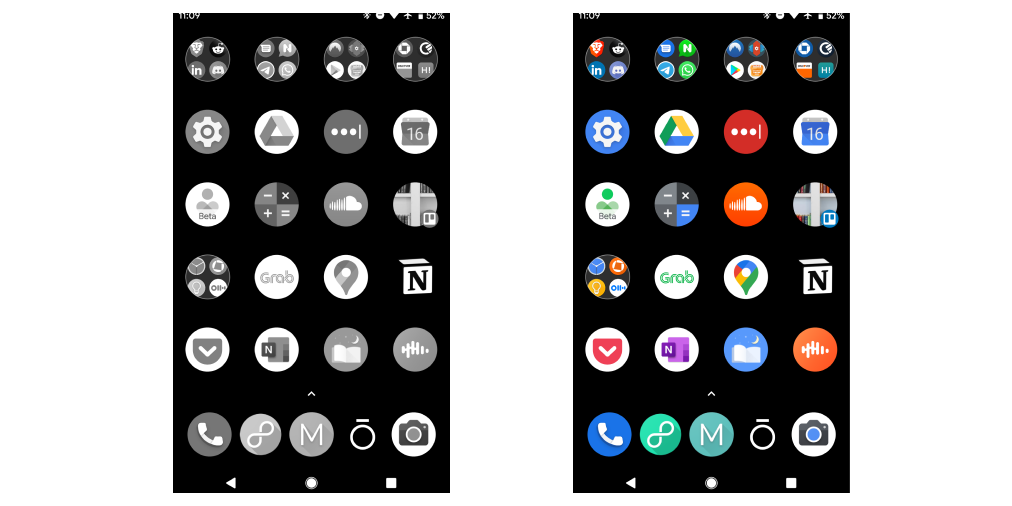
Instead of going full-on grayscale, I set up my phone to automatically go on grayscale at night, to limit my phone usage before bed and ensuring a good night’s sleep.
Android Instructions: Settings → Digital Wellbeing → Bedtime Mode → Customize → Grayscale (on)
iPhone Instructions: On iPhone, you cannot set up Grayscale to turn on automatically at certain times. Alternatively, you can set it up as a Shortcut by going to:
Settings > General > Accessibility > Accessibility Shortcut > Color Filters Now you can enable or disable grayscale by pressing the home button three times (iPhone X triple-tap the side button).
2.2 One-page Home Screen
Another one-time action that will help you spend less time on your phone is moving all your apps to one page by using folders and the principles explained below.
This might sound scary at first, but I encourage you to give it a try, as it can be extremely powerful.
The process of forcing all apps in one page alone will help you re-consider all the apps that you have installed.
More importantly, having all apps in one page will eliminate any obsessive swiping (nothing to swipe, sorry!). Over time, your brain learns that and stops seeking entertainment from your phone.
As you’ll see in Step 3 below, a one page home screen is easier to arrange intentionally, gives you more control over your phone and makes you more productive.
This process naturally links to Principle #3.
3. Make positive behaviors visible and easy (and “negative” ones hidden and difficult)
3.1 Arranging your home screen
If you have everything on one page, it’s easier to be intentional with the apps you want to make easier to access. Even if you didn’t put everything on one page, you can take 10 minutes to re-arrange your home screen(s) to encourage positive behaviors and discourage negative ones (inspired by Jordan Lejuwaann).
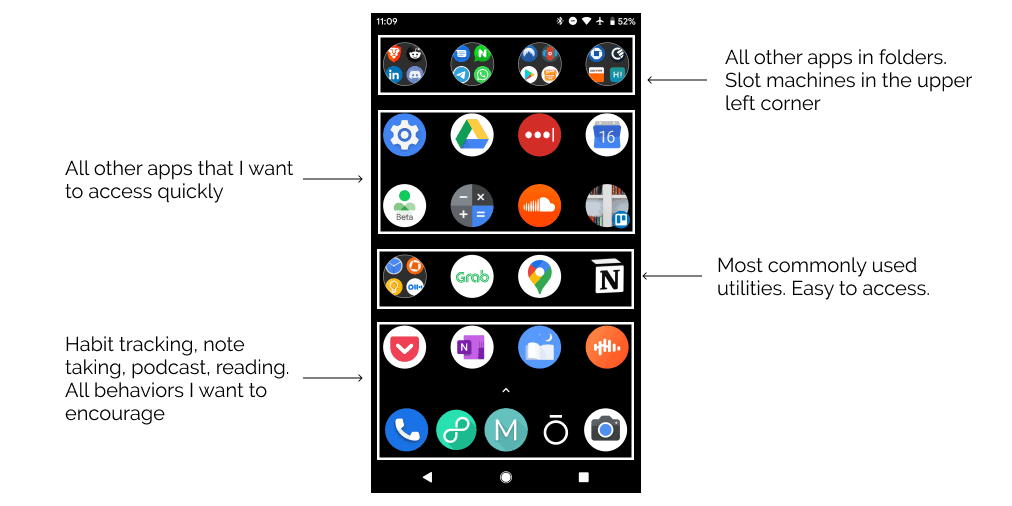
You can do so by following these steps:
i. Place the apps that you want to use more at the bottom, close to the reach of your thumb.
These are apps that you use for a specific, wholesome purpose like reading (Pocket), Note-taking, To-Dos, Habit Tracking.
ii. If you can’t uninstall them, hide slot-machine apps in folders, placed at the top (farther from your thumb)
Slot machine apps are those that you compulsively check for notifications.
They lure you in with intermittent rewards and make you scroll indefinitely. You might open Instagram to check a DM, and get sucked into 30 minutes of watching friends’ stories. Usually, social media apps or news fall in this category but even email may be a slot-machine app.
iii. Arrange other apps based on use
The remaining apps are likely going to be “Tools”, that you open for a specific purpose and close back. Examples of these are Uber, Calculator, Google Maps, etc.. Depending on how often you use a Tool, place it in an easier to reach spot (for frequent use) or in a folder.
3.2 Turn off “raise to wake”
“Raise to wake” allows you to check your phone simply by raising it up. While seemingly convenient, this feature makes an addictive behavior (checking your phone) easier. It also drains your battery.
Android Instructions: Settings → Display. → Advanced → Lockscreen Display → Raise to Wake (off) → Lift to check phone
iPhone Instructions: Settings → Display and Brightness. → Raise to Wake (off)
3.3 Keep your phone outside the bedroom
You may have heard similar advice before. If so, it’s because it works! Really well.
This might be the most effective measure that I’ve taken out of all in this article.
A lot of unintentional phone usage happens in bed, either before going to sleep or upon waking up. In either case, it’s harmful (for your sleep quality or the way you start your day) and causes a lot of time waste.
Make a rule and stick to it for sometime.
Once you try it, even for a few days, whenever you fall back and use your phone in bed, you’ll be more aware of the huge time and energy suck that it causes you.
This will create a positive feedback loop. You only need to set it in motion and watch it do the work.
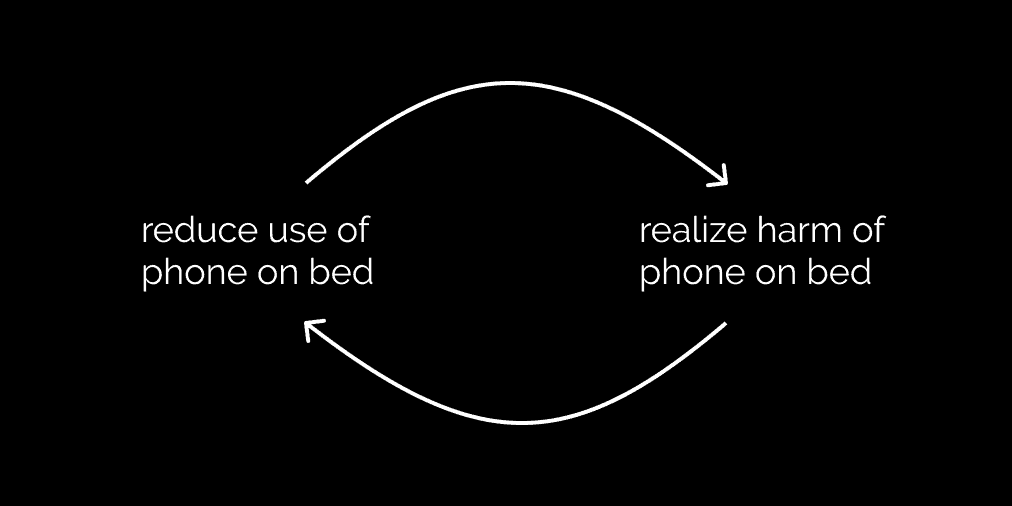
4. Nurture your focus and attention
“Notifications” is a nicer word to mean “distractions”.
They are continuous, uncontrolled interruptions from our work and our goals. It is undeniable that we need to focus on a task to reach a flow state and do our best work. Notifications might easily be the reason why you are not able to reach that flow state consistently.
We might tell ourselves that we won’t check them when we work. But again, the addictive slot-machine mechanism makes it hard to resist or requires a lot of mental effort, draining our energy.
4.1 Set Up Recurring “Do Not Disturb”
If you have a fixed work schedule when you need to focus, you can set up Do Not Disturb to automatically turn on at those times. Set up Do Not Disturb to turn off all sound notifications except for delivery apps, maps, and time-sensitive apps that won’t distract you from work.
If it feels too hard to turn off sound for messages and emails, remember that most messages don’t require an instant response. You will be much more productive if you schedule times to answer all the texts and emails at once. If something urgent comes up, people can still reach you by calling.
Android Instructions: open the notification shade (swipe down) → long tap on the Do Not Disturb icon → Schedules → Set up different schedules for it to turn on automatically
iPhone Instructions: Settings → Do Not Disturb → Schedule (on) → Set up your time
4.2 Turn off all (or most) lockscreen notifications
Setting up “Do Not Disturb” will turn off the sound of your notifications, but you will still see all the notifications on your lock screen every time you check your phone. Even if you only wanted to check the time.
This makes your phone itself a slot-machine. We are tempted to check it often because we want to see if we received any dopamine-inducing notifications.
A way around this that worked well for me was to turn off the notifications on the lockscreen. That way, once I unlock my phone I will still be able to see all the notifications, but not when my phone is still locked. The lock screen becomes a sort of zen, safe place, instead of an overwhelming, “urgent” list of things to address.
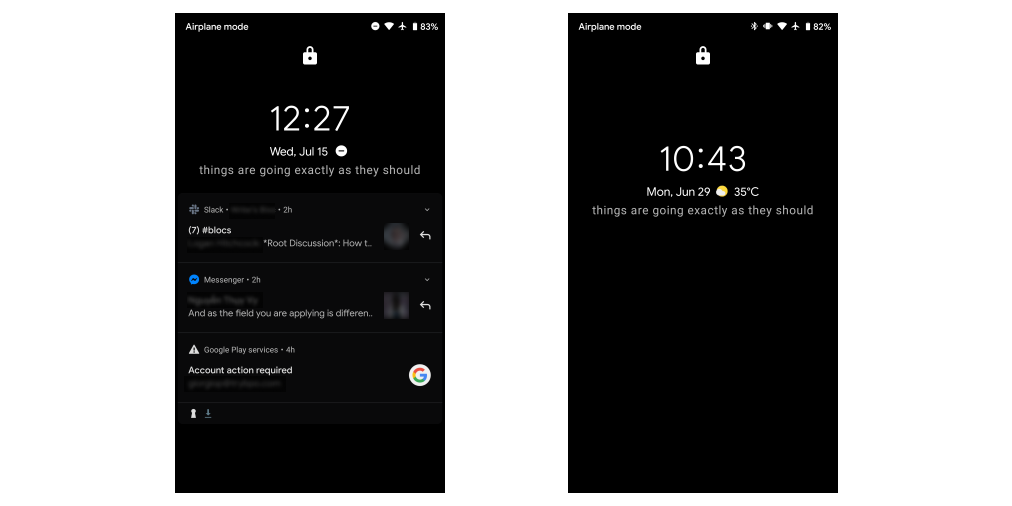
On Android: to select which notifications you want to see on your lockscreen and which ones you don’t go to Settings → Apps and notifications → Select an app → Select a type of notification → Advanced → Lock Screen → Don’t show notifications at all
If you want to go extreme and turn off all lockscreen notifications go to Settings → Display. → Advanced → Lockscreen Display → Under Lockscreen select “do not show notifications at all”.
On iPhone: to select which notifications you want to see on your lockscreen and which ones you don’t go to Settings → Notifications → Select an app → Click on Lockscreen to disable it (blue badge disappears).
5. Schedule your distractions
Closely related is the concept of scheduling distractions.
Some slot-machine apps undoubtedly can provide value, if we use them intentionally.
What you can do, to avoid being sucked into infinite scrolling loops, is to schedule set times for you to indulge in those distractions.
Outside of those times, know how dangerous distractions can be, and stay away from them.
On Android, a good way to do so is using the new Focus Mode. It allows you to select the apps that you want to block at certain times. If you really want to use the app, you can still select take a break and select the time of your break.
In theory, you could take as many “breaks” as you want, but the simple act of deciding in advance a time to use the distracting app makes me much more mindful of the time I spend on it.
With this feature you get the best of both worlds, you still use any of your apps when you want to, but you are forced to be more aware of the time you spend on them. Thus avoiding being sucked into them for hours.
To activate it: Go to Settings → Digital Wellbeing → Focus Mode → select the apps and times that you want to block.
On iPhone: this feature is not native, and I could not find any similar free alternative on the App Store. What you can do (through the Screen Time setting) is to set up daily time limits on the apps that distract you the most. That way, every time you spend more than a certain amount of time on some distracting apps, your phone will let you know and will “gently” block the app. I said gently, because you can decide to override the block and increase your time limit in one tap.
To do so: go to Settings → Screen Time → App Limits → Add Limit
As I started writing this article I became more serious about these concepts and found myself a lot more productive throughout the day.
If you read this far, I’d love to hear your thoughts on the subject and any feedback if you implemented any of these tips.
This post was partly inspired by Jordan Lejuwann‘s article 9 Micro-Hacks That Made Me Faster, Happier and More Sane and by this Kunal’s tweet.